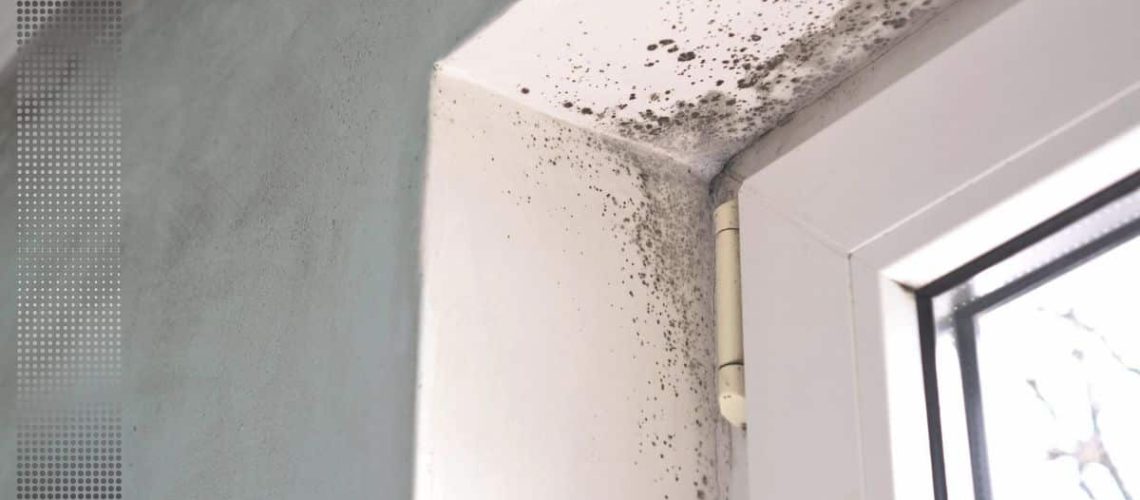If you’ve spotted mold growing on your bathroom ceiling, it’s more than just a cosmetic problem. Bathroom mold is a sign of moisture issues, and depending on how long it’s been there, it may be affecting your indoor air quality in ways you can’t see.
Mold spores can circulate through your home and trigger symptoms like coughing, fatigue, and allergic reactions. The longer mold sits, the more likely it is to spread into other rooms, behind walls, or into your air system.
In this guide, we’ll break down what causes mold on the bathroom ceiling, how it can affect the air you breathe, and when to bring in a professional for testing and inspection.
Table of Contents
ToggleWhat Causes Mold to Grow on the Ceiling?
Bathrooms are one of the most common places for mold to appear indoors. The warm, damp environment provides ideal conditions for mold growth, especially if ventilation is limited or moisture is allowed to build up over time.
Here are the most common causes:
- Poor ventilation: Without proper airflow, steam from showers can collect near the ceiling and soak into the surface
- High humidity: In humid climates, the bathroom air may already hold more moisture than the room can handle
- Condensation: Warm air meeting a cool ceiling can create moisture buildup, especially in corners or near vents
- Leaks: Water from above, such as a roof or attic leak, can seep into the ceiling and allow mold to grow undisturbed
- Organic buildup: Soap scum, dust, or even dead skin cells can serve as a food source for mold on the ceiling surface
Mold may start as small specks or faint discoloration, but it often spreads quickly once conditions are right. Research shows that nearly half of U.S. homes report dampness or visible mold at least once.

How Ceiling Mold Affects Indoor Air Quality
Even if the mold stays in one place visually, the air in your home doesn’t. As mold grows, it releases microscopic spores that can become airborne and circulate through your space.
Inhaling mold spores may lead to:
- Sneezing and congestion
- Itchy or watery eyes
- Sore throat
- Persistent coughing
- Worsening asthma or other breathing conditions
- Fatigue or brain fog
Children, older adults, and anyone with respiratory or immune conditions are more likely to notice symptoms quickly. But even healthy individuals may experience long-term effects from ongoing exposure to mold-filled air.
It’s not just about comfort. Poor indoor air quality can affect your sleep, focus, and overall well-being.
Can Mold on the Bathroom Ceiling Spread?
Yes. The visible mold on your ceiling may be just one part of the problem. Mold spores can travel through the air and land on other surfaces throughout the home. If those surfaces are damp or porous, mold can start to grow there too.
Some of the most common areas for secondary mold growth include:
- Behind drywall
- Inside attic insulation
- Around air vents and return ducts
- Behind baseboards
- Under flooring in nearby rooms
That’s why it’s important to act quickly. Surface mold can often be cleaned, but hidden mold usually requires professional inspection and remediation.
What to Do If You See Mold on the Bathroom Ceiling
If the mold is small and limited to a non-porous surface, you may be able to clean it safely. However, scrubbing mold without understanding the extent of the issue could make things worse by releasing more spores into the air.
Here’s what you can try:
- Clean with caution: Use a bathroom-safe mold cleaner or white vinegar on tile or painted drywall
- Ventilate the space: Run the exhaust fan or open a window to increase airflow while cleaning
- Wear protection: Use gloves and a mask to reduce direct exposure to spores
- Monitor for regrowth: If the mold comes back within a few days or weeks, the source of moisture likely remains unresolved
If the mold reappears, spreads beyond one area, or is accompanied by musty smells, staining, or damp patches, don’t wait. That’s when it’s time to call for help.

Why a Professional Mold Inspection Matters
Bathroom ceiling mold can sometimes be cleaned at the surface level, but often, it points to a deeper issue. Water could be collecting behind the ceiling or spreading into the attic. Mold might be growing where you can’t see it.
A professional mold inspection and indoor air quality test can:
- Identify the type and concentration of mold in your home
- Reveal whether spores have spread beyond the bathroom
- Detect hidden moisture sources behind walls or above ceilings
- Measure airborne contaminants and assess ventilation quality
- Provide a clear report and action plan for treatment or repairs
Inspection Gator specializes in mold inspections and air quality testing for homeowners in Texarkana and the surrounding area. Our inspections go beyond what’s visible and help you understand the full scope of the issue, so you can move forward with clarity and confidence.
Related Questions Homeowners Ask
Is bathroom mold always dangerous?
Not always, but even non-toxic mold can lower your air quality and cause symptoms. Large patches or recurring growth should always be taken seriously.
Can mold on the ceiling cause permanent damage?
Yes. If left untreated, mold can weaken drywall, damage paint and finishes, and even lead to rot in structural materials above the ceiling.
How do I know if the mold has spread into the attic or walls?
A professional inspection is the best way to know for sure. Signs like musty odors, damp spots, or visible staining around the bathroom may indicate a wider problem.
What happens during an air quality test?
Air samples are taken in different parts of the home and sent to a lab for analysis. The results will show the types and levels of mold spores or other contaminants in the air.
When to Call a Professional
You should schedule a mold inspection if:
- The mold has spread beyond one area
- It keeps returning after cleaning
- You notice musty odors that don’t go away
- Anyone in your home has worsening allergy or asthma symptoms
- You plan to sell or remodel your home and want to rule out hidden damage
Even if the mold seems small, it’s better to know what you’re dealing with than to guess.
Final Thoughts
Mold on the bathroom ceiling may seem like a small issue, but it can have big effects on the air your family breathes. From respiratory symptoms to hidden water damage, mold should always be addressed at the source.
If you’re unsure how far the problem has spread, or if you want peace of mind about your home’s air quality, schedule a professional mold inspection with a trusted local team.
Inspection Gator is here to help you identify, understand, and solve mold issues before they get worse, so you can breathe easier and live healthier at home.





